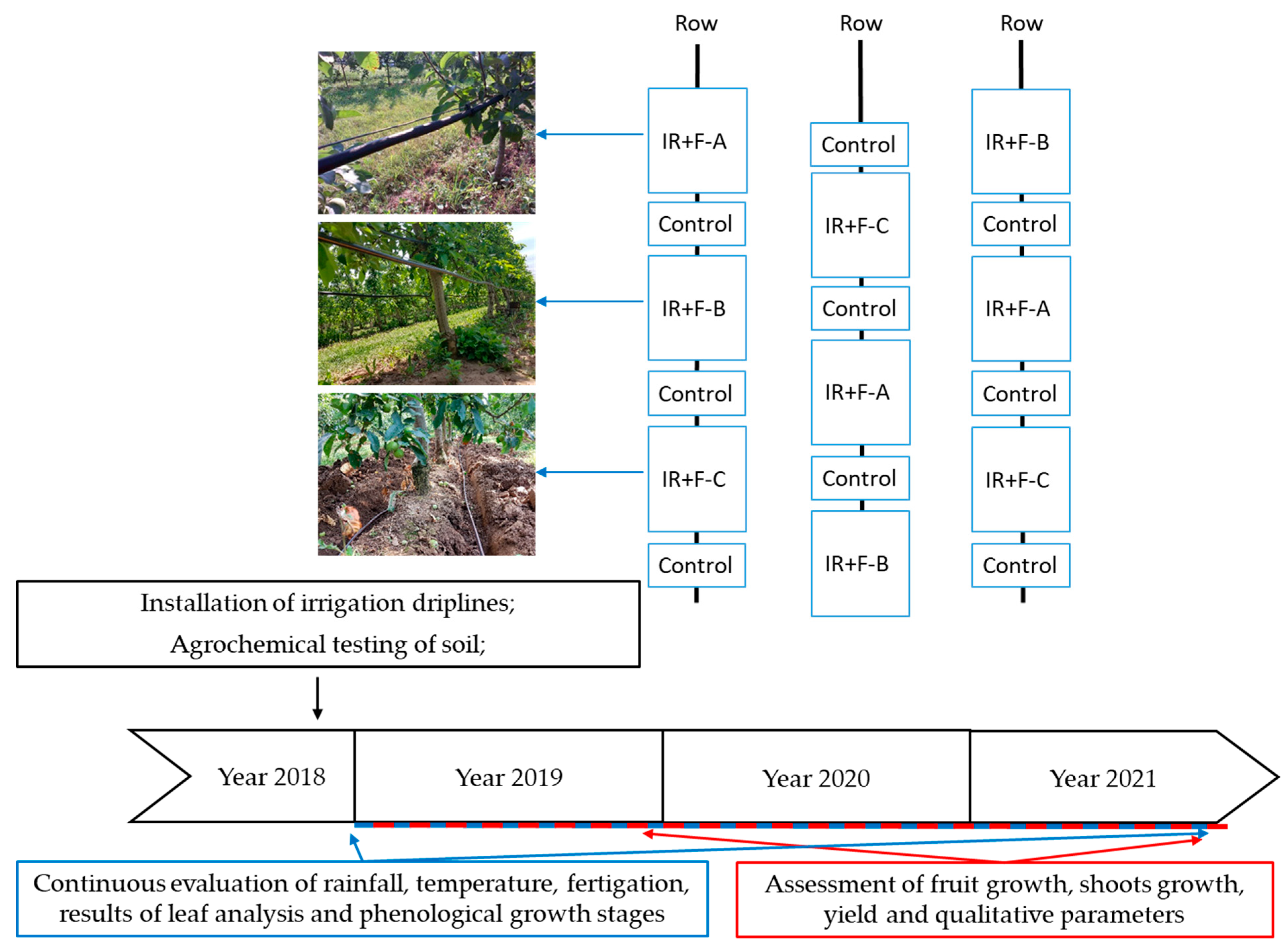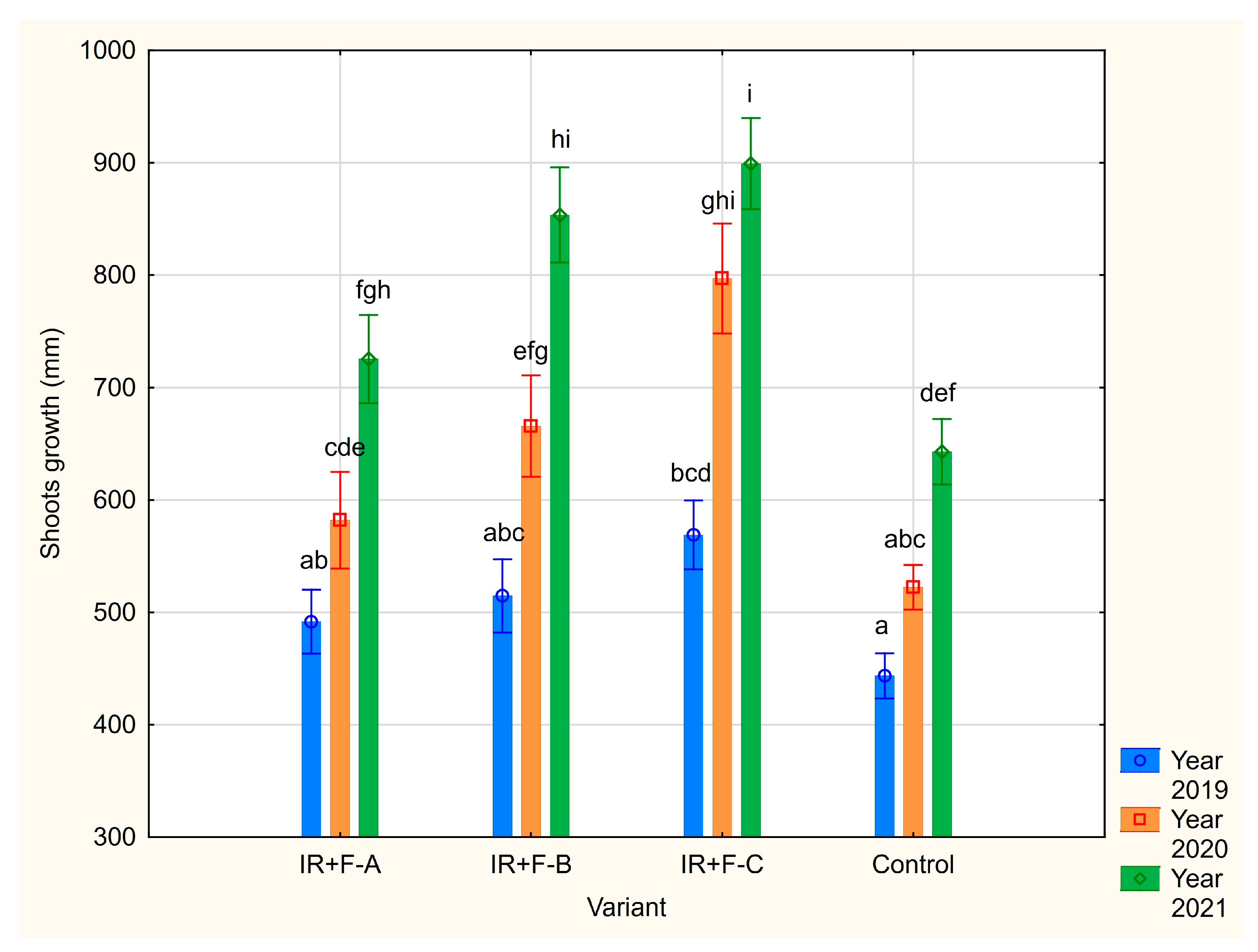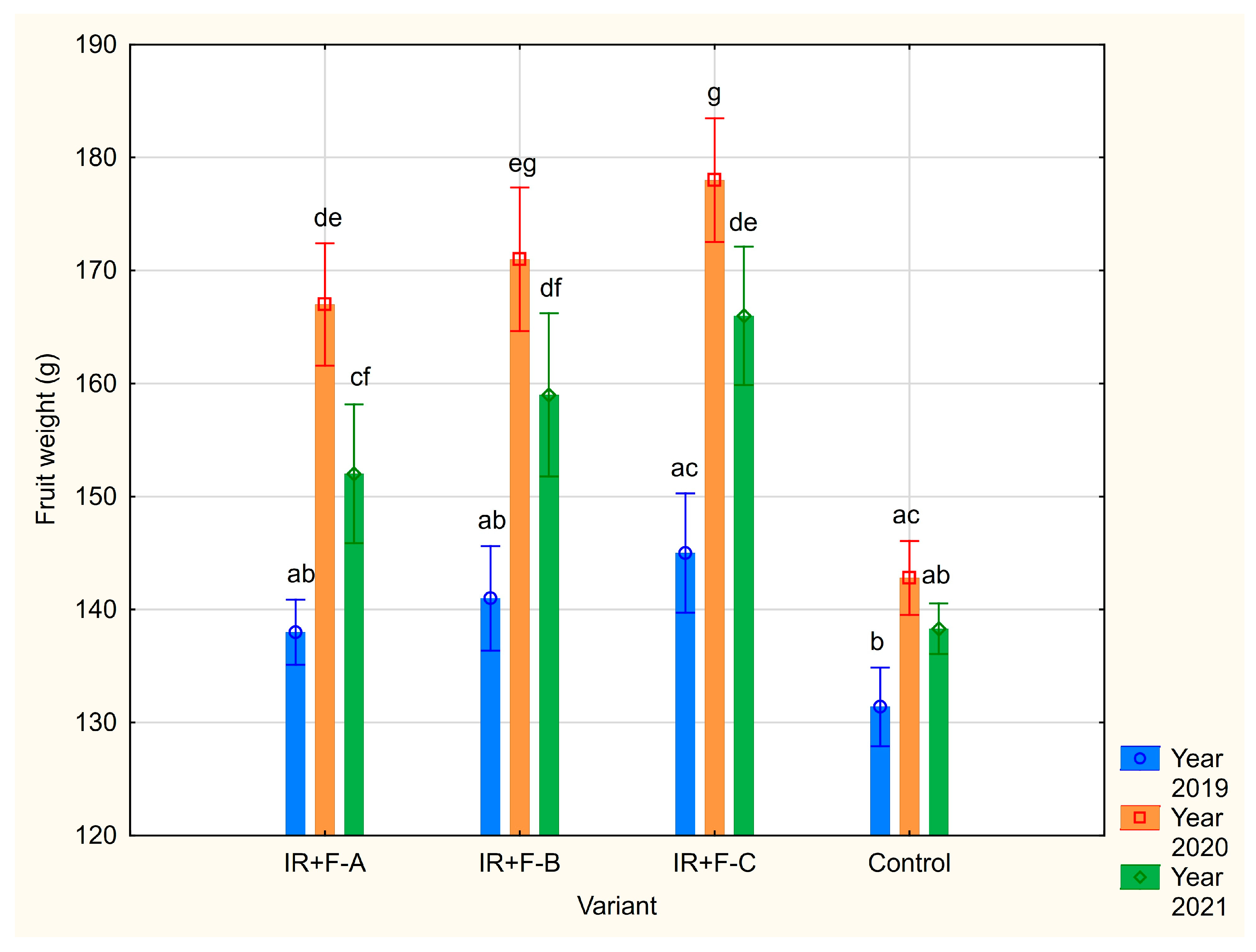The Evaluation of the Impact of Different Drip Irrigation Systems on the Vegetative Growth and Fruitfulness of ‘Gala’ Apple Trees
Abstract
1. Introduction
2. Materials and Methods
2.1. Experimental Location and Plant Material
2.2. Soil and Climate Characteristics
2.3. Drip Irrigation System–Experimental Treatments
- V—is the volume of irrigation water, L;
- ρ—is the volumetric weight of the soil, 1.45 g·cm−3;
- h—is the planned soil wetting depth, 0.8 m;
- p—is the wetting ratio, 0.25;
- S—is the area of the soil surface per 1 apple tree, 3.6 m2;
- Δθ—moisture content of the soil profile;
- ψ—is the coefficient of irrigation water use, ψ = 0.95.
- the constant 0.1 is a unit conversion factor used to express the result in liters, based on the combination of input units (g·cm−3, m2, m).
- IR+F-A: Single aerial suspended dripline—one drip line placed on a wire line 0.5 m above the soil surface in a row—common method
- IR+F-B: Double aerial suspended driplines—two drip lines placed on an auxiliary structure on the left and right side of the trees, 0.35 m from the tree, and 0.5 m above the soil surface
- IR+F-C: Double subsurface driplines—two drip lines placed on the left and right side of the trees, 0.35 m from the tree, and 0.3 m below the soil surface
2.4. Measurement of Shoot Growth
2.5. Yield Parameters and Apple Quality
2.6. Statistical Analysis
3. Results and Discussion
3.1. Shoot Growth
3.2. Fruit Growth
3.3. Production
3.4. Results Applicable to Practice
4. Conclusions
Author Contributions
Funding
Data Availability Statement
Conflicts of Interest
References
- Milošević, T.; Milošević, N.; Mladenović, J. The influence of organic, organo-mineral and mineral fertilizers on tree growth, yielding, fruit quality and leaf nutrient composition of apple cv. ‘Golden Delicious Reinders’. Sci. Hortic. 2022, 297, 110978. [Google Scholar] [CrossRef]
- FAO. FAOSTAT Production Database; FAO (The State of Food and Agriculture): Rome, Italy, 2022; Available online: http://faostat.fao.org (accessed on 15 November 2023).
- Backes, M.; Blanke, M. Water consumption and xylem flux of apple trees. Acta Hortic. 2007, 732, 573–578. [Google Scholar] [CrossRef]
- Sun, M.; Gao, X.; Zhang, Y.; Song, X.; Zhao, X. A new solution of high-efficiency rainwater irrigation mode for water management in apple plantation: Design and application. Agric. Water Manag. 2022, 259, 107243. [Google Scholar] [CrossRef]
- Tong, X.; Wu, P.; Liu, X.; Zhang, L.; Zhou, W.; Wang, Z. A global meta-analysis of fruit tree yield and water use efficiency under deficit irrigation. Agric. Water Manag. 2022, 260, 107321. [Google Scholar] [CrossRef]
- Zhang, B.; Su, S.; Duan, C.; Feng, H.; Chau, H.W.; He, J.; Li, Y.; Hill, R.L.; Wu, S.; Zou, Y. Effects of partial organic fertilizer replacement combined with rainwater collection system on soil water, nitrate-nitrogen and apple yield of rainfed apple orchard in the Loess Plateau of China: A 3-year field experiment. Agric. Water Manag. 2022, 260, 107295. [Google Scholar] [CrossRef]
- Ruiz-Sánchez, M.C.; Abrisqueta, I.; Conejero, W.; Vera, J. Deficit Irrigation Management in Early-Maturing Peach Crop. In Water Scarcity and Sustainable Agriculture in Semiarid Environment; Academic Press: Cambridge, MA, USA, 2018; pp. 111–129. [Google Scholar]
- Ruiz-Sanchez, M.C.; Domingo, R.; Castel, J.R. Review. Deficit irrigation in fruit trees and vines in Spain. Span. J. Agric. Res. 2010, 8, 5–20. [Google Scholar] [CrossRef]
- Jovanovic, Z.; Stikic, R. Partial Root-Zone Drying Technique: From Water Saving to the Improvement of a Fruit Quality. Front. Sustain. Food Syst. 2018, 1. [Google Scholar] [CrossRef]
- Liao, Y.; Cao, H.-X.; Xue, W.-K.; Liu, X. Effects of the combination of mulching and deficit irrigation on the soil water and heat, growth and productivity of apples. Agric. Water Manag. 2021, 243, 106482. [Google Scholar] [CrossRef]
- Ebel, R.C.; Proebsting, E.L.; Patterson, M.E. Regulated Deficit Irrigation May Alter Apple Maturity, Quality, and Storage Life. HortScience 1993, 28, 141–143. [Google Scholar] [CrossRef]
- Mpelasoka, B.S.; Hossein Behboudian, M. Production of aroma volatiles in response to deficit irrigation and to crop load in relation to fruit maturity for ‘Braeburn’ apple. Postharvest Biol. Technol. 2002, 24, 1–11. [Google Scholar] [CrossRef]
- Boland, A.M.; Mitchell, P.D.; Jerie, P.H. Effect of saline water combined with restricted irrigation on peach-tree growth and water-use. Aust. J. Agric. Res. 1993, 44, 799–816. [Google Scholar] [CrossRef]
- Iqbal, R.; Raza, M.A.S.; Toleikiene, M.; Ayaz, M.; Hashemi, F.; Habib-ur-Rahman, M.; Zaheer, M.S.; Ahmad, S.; Riaz, U.; Ali, M.; et al. Partial root-zone drying (PRD), its effects and agricultural significance: A review. Bull. Natl. Res. Cent. 2020, 44, 159. [Google Scholar] [CrossRef]
- Ghafari, H.; Hassanpour, H.; Jafari, M.; Besharat, S. Physiological, biochemical and gene-expressional responses to water deficit in apple subjected to partial root-zone drying (PRD). Plant Physiol. Biochem. 2020, 148, 333–346. [Google Scholar] [CrossRef] [PubMed]
- Ben Messaouda, M.; Aounallah, M.K.; Hammami, S.; Bettaieb, T.; Sahli, A. Effect of partial rootzone drying on growth, yield and fruit quality of ‘Starkrimson’ apple cultivar (Malus domestica Borkh). Acta Hortic. 2017, 1160, 403–408. [Google Scholar] [CrossRef]
- Durovic, D.; Mratinic, E.; Milatovic, D.; Durovic, S.; Dordevic, B.; Milivojevic, J.; Radivojevic, D. Effects of Partial Rootzone Drying and Deficit Irrigation of ‘Granny Smith’ Apples on Fruit Quality during Storage. In Proceedings of the 2nd International Symposium on Horticulture in Europe (SHE), Angers, France, 1–5 July 2012; pp. 455–461. [Google Scholar]
- Zegbe, J.A.; Serna-Pérez, A. Partial rootzone drying maintains fruit quality of ‘Golden Delicious’ apples at harvest and postharvest. Sci. Hortic. 2011, 127, 455–459. [Google Scholar] [CrossRef]
- Zegbe, J.A.; Serna-Pérez, A.; González-Fuentes, J.A. Nutrient status of apple leaves not affected by three years of irrigation using partial rootzone drying. J. Plant Nutr. Soil Sci. 2011, 174, 459–464. [Google Scholar] [CrossRef]
- Lo Bianco, R.; Talluto, G.; Farina, V. Effects of partial rootzone drying and rootstock vigour on dry matter partitioning of apple trees (Malus domestica cvar Pink Lady). J. Agric. Sci. 2012, 150, 75–86. [Google Scholar] [CrossRef]
- Rana, G.; Katerji, N. Measurement and estimation of actual evapotranspiration in the field under Mediterranean climate: A review. Eur. J. Agron. 2000, 13, 125–153. [Google Scholar] [CrossRef]
- Su, Q.; Singh, V.P.; Karthikeyan, R. Improved reference evapotranspiration methods for regional irrigation water demand estimation. Agric. Water Manag. 2022, 274, 107979. [Google Scholar] [CrossRef]
- Xu, H.; Ediger, D. Rootstocks with Different Vigor Influenced Scion–Water Relations and Stress Responses in AmbrosiaTM Apple Trees (Malus Domestica var. Ambrosia). Plants 2021, 10, 614. [Google Scholar] [CrossRef] [PubMed]
- Neilsen, D.; Neilsen, G.H.; Gregory, D.; Forge, T.; Zebarth, B. Drainage losses of water, N and P from micro-irrigation systems in a young, high density apple planting. Acta Hortic. 2008, 792, 483–490. [Google Scholar] [CrossRef]
- Han, S.G.; Selvakumar, G.; Yi, P.H.; Lee, S.E. Effect of Sprinkler, Surface Drip and Subsurface Drip Irrigation Methods on ‘Fuji’/M9 and ‘Fuji’/M26 Apple Orchards Growth, Soil Properties, and Water Consumption. Korean J. Soil Sci. Fertil. 2018, 51, 608–615. [Google Scholar] [CrossRef]
- Naor, A.; Klein, I.; Doron, I.; Gal, Y.; BenDavid, Z.; Bravdo, B. The effect of irrigation and crop load on stem water potential and apple fruit size. J. Hortic. Sci. 1997, 72, 765–771. [Google Scholar] [CrossRef]
- Al-Ghobari, H.M.; Mohammad, F.S.; Marazky, M.S.A.E.; Dewidar, A.Z. Automated irrigation systems for wheat and tomato crops in arid regions. Water SA 2017, 43, 354–364. [Google Scholar] [CrossRef]
- Deekshithulu, N.V.G.; Babu, G.; Babu, R.; Ramakrishna, M. Development of Software for the Microcontroller Based Automated Drip Irrigation System Using Soil Moisture Sensor. Int. J. Curr. Microbiol. Appl. Sci. 2018, 7, 1385–1393. [Google Scholar] [CrossRef]
- Raina, J.N.; Suman, S.; Kumar, P.; Spehia, R.S. Effect of Drip Fertigation With and Without Mulch on Soil Hydrothermal Regimes, Growth, Yield, and Quality of Apple (Malus domestica Borkh). Commun. Soil Sci. Plant Anal. 2013, 44, 2560–2570. [Google Scholar] [CrossRef]
- Kadayifçı, A.; Şenyigit, U.; Dağdelen, N.; Öz, H.; Atilgan, A. The effects of different irrigation methods on root distribution, intensity and effective root depth of young dwarf apple trees. Afr. J. Biotechnol. 2010, 9, 4217–4224. [Google Scholar]
- Fallahi, E.; Fallahi, B.; Shafii, B. Water use, mineral nutrition, tree growth, yield, and fruit quality of ‘Fuji’ and ‘Gala’ apples under various irrigation systems and root stocks. Acta Hortic. 2013, 984, 57–68. [Google Scholar] [CrossRef]
- Fallahi, E.; Fallahi, B.; Kiester, M.; Mahdavi, S.; Shafii, B. Water application for optimum yield, quality, and mineral partitioning in apples under different irrigation systems. Acta Hortic. 2017, 1150, 211–218. [Google Scholar] [CrossRef]
- Nazari, E.; Besharat, S.; Zeinalzadeh, K.; Mohammadi, A. Measurement and simulation of the water flow and root uptake in soil under subsurface drip irrigation of apple tree. Agric. Water Manag. 2021, 255, 106972. [Google Scholar] [CrossRef]
- Wünsche, J.; Ferguson, I. Crop Load Interactions in Apple. In Horticultural Reviews; Janick, J., Ed.; John Wiley & Sons, Inc.: Hoboken, NJ, USA, 2010; Volume 31, pp. 231–290. [Google Scholar]
- Mpelasoka, B.S.; Behboudian, M.H.; Green, S.R. Effects of irrigation regime and crop load on water use and yield of ‘Braeburn’ apple grown in Lysimeters. Acta Hortic. 2000, 537, 741–748. [Google Scholar] [CrossRef]
- IUSS World Reference Base for Soil Resources; International Soil Classification System for Naming Soils and Creating Legends for Soil Maps, 4th ed.; International Union of Soil Sciences (IUSS): Vienna, Austria, 2022; Available online: https://www.isric.org/sites/default/files/WRB_fourth_edition_2022-12-18.pdf (accessed on 15 April 2024).
- Methodological Instruction n. 9/SZV; Working Procedure for Agrochemical Testing of Agricultural Soils in the Czech Republic from 2016–2022; UKZUZ (Central Institute for Supervising and Testing in Agriculture): Brno, Czech Republic, 2016. Available online: https://mze.gov.cz/public/portal/-q455981---7iLguttU/mp-01-azzp-3-vyd?_linka=a312153.pdf (accessed on 18 January 2024).
- EN 15936; Soil, Waste, Treated Biowaste and Sludge—Determination of Total Organic Carbon (TOC) by Dry Combustion. CEN (European Committee for Standardization): Brussel, Belgium, 2022.
- Miklos, L. Landscape Atlas of the Slovak Republic; Institute of Landscape Ecology of the Slovak Academy of Sciences: Bratislava, Slovakia, 2002. [Google Scholar]
- Ben Abdelkader, A.; Thalheimer, M.; Petrillo, M.; Tagliavini, M.; Zanotelli, D. Automatic irrigation scheduling based on soil water potential thresholds allows water savings in a highly productive apple orchard. Acta Hortic. 2022, 1346, 563–570. [Google Scholar] [CrossRef]
- Zegbe, J.A.; Behboudian, M.H.; Lang, A. Partial rootzone drying advances fruit maturity of royal Gala apple. Rev. Fitotec. Mex. 2016, 39, 187–192. [Google Scholar] [CrossRef][Green Version]
- Schöne, R.; Metzner, S. Evaluierung von Sorten für den Tafelapfelanbau in Sachsen. Schriftenreihe LfULG 2012, 30, 1–67. Available online: https://publikationen.sachsen.de/bdb/artikel/11443/documents/19220 (accessed on 24 July 2025).[Green Version]
- UNECESTANDARDFFV-50; Concerning the Marketing and Commercial Quality Control of APPLES. United Nations: New York, NY, USA, 2012.
- Reid, M.; Kalcsits, L. Water Deficit Timing Affects Physiological Drought Response, Fruit Size, and Bitter Pit Development for ‘Honeycrisp’ Apple. Plants 2020, 9, 874. [Google Scholar] [CrossRef]
- González Nieto, L.; Huber, A.; Gao, R.; Cheng, L.; Stroock, A.D.; Lakso, A.N.; Robinson, T.L. Managing Water Stress to Maximize ‘Gala’ Apple Fruit Size Using Micro-Tensiometers. Acta Hortic. 2023, 1409, 281–290. [Google Scholar] [CrossRef]
- Küçükyumuk, C.; Kaçal, E.; Yildiz, H. Effects of Different Deficit Irrigation Strategies on Yield, Fruit Quality and Some Parameters: Braeburn Apple Cultivar. Not. Bot. Horti Agrobot. Cluj-Napoca 2013, 41, 510–517. [Google Scholar] [CrossRef]
- Lo Bianco, R. Water-Related Variables for Predicting Yield of Apple under Deficit Irrigation. Horticulturae 2019, 5, 10. [Google Scholar] [CrossRef]
- Robinson, T.L.; He, P.; Brown, M.W.; Fazio, G.; Reighard, G.L.; Aldwinckle, H.S. Precision Orchard Management: A New Approach to Orchard Design and Management. HortTechnology 2013, 23, 435–441. [Google Scholar]
- Webster, A.D.; Atkinson, C.J.; Lucas, A.S.; Vaughan, S.P.; Taylor, L. Interactions between root restriction, irrigation and rootstock treatments on the growth and cropping of ‘Queen Cox’ apple trees: Effects on orchard growth and cropping. J. Hortic. Sci. Biotechnol. 2000, 75, 181–189. [Google Scholar] [CrossRef]
- Zhu, X.; Li, Y.; Wang, Q.; Zhang, J.; Gao, S. Effect of Water-Fertilizer Coupling on the Growth and Physiological Performance of Young Apple Trees. Agronomy 2023, 13, 2506. [Google Scholar] [CrossRef]
- Plavcová, L.; Jupa, R.; Mészáros, M.; Scháňková, K.; Kovalíková, Z.; Náměstek, J. Stem Water Potential, Stomatal Conductance and Yield in Irrigated Apple Trees. Plant Soil Environ. 2023, 69, 303–313. [Google Scholar] [CrossRef]
- Neilsen, D.; Neilsen, G.H. Efficient Use of Nitrogen and Water in High-density Apple Orchards. HortTechnology 2002, 12, 19–25. [Google Scholar] [CrossRef]
- Yıldırım, F.; Vural, E.; Uçar, Y.; Yıldırım, A.N. Interaction of Crop Load and Irrigation on Yield, Fruit Size, Color and Stem-end Splitting Ratio of Apple c.v. ‘Gala, Galaxy’. Erwerbs-Obstbau 2016, 58, 103–111. [Google Scholar] [CrossRef]
- Tanasescu, N.; Paltineanu, C. Root distribution of apple tree under various irrigation systems within the hilly region of Romania. Int. Agrophys. 2004, 18, 175–180. [Google Scholar]
- Mert, C.; Ertürk, Ü.; Soylu, A.; Öztürk, Ö. The King Fruit versus Lateral Fruit Thinning Effects on Yield and Fruit Quality in Apple. Int. J. Fruit Sci. 2007, 7, 37–46. [Google Scholar] [CrossRef]
- Robinson, T.L. Interaction of fertilization, rootstock and irrigation on growth, thinning efficiency, yield and fruit quality of ‘Empire’ apple. Acta Hortic. 2006, 721, 41–48. [Google Scholar] [CrossRef]
- Ucar, Y.; Kadayıfcı, A.; Askın, M.A.; Kankaya, A.; Senyiğit, U.; Yıldırım, F. Yield and Quality Response of Young ‘Gala, Galaxy’ Trees under Different Irrigation Regimes. Erwerbs-Obstbau 2016, 58, 159–167. [Google Scholar] [CrossRef]
- Wang, N.; Wolf, J.; Zhang, F.-S. Towards sustainable intensification of apple production in China—Yield gaps and nutrient use efficiency in apple farming systems. J. Integr. Agric. 2016, 15, 716–725. [Google Scholar] [CrossRef]






| Parameter | P (mg·kg−1) | K (mg·kg−1) | Ca (mg·kg−1) | Mg (mg·kg−1) | pH (–) | TOC (%) |
|---|---|---|---|---|---|---|
| Average value | 142 | 441 | 3737 | 391 | 7.2 | 2.1 |
| Word classification | Good | High | High | High | Neutral | Middle |
| Year | Average Annual Temperature (°C) | Sum of Precipitation (mm) | Sum of Irrigation Volumes (mm) | Sum of Water (mm) |
|---|---|---|---|---|
| Averages of previous years | 10.4 | 673 | 801 | 1474 |
| 2019 | 11.3 | 704 | 675 | 1379 |
| 2020 | 11.0 | 681 | 449 | 1130 |
| 2021 | 10.2 | 631 | 674 | 1305 |
| Date of Application of the Given Fertilizer in a Specific Year | |||
|---|---|---|---|
| Type of Fertilizer | 2019 | 2020 | 2021 |
| Ammonium sulfate, | 13.4 | 29.4 | 17.4 |
| Iron chelate 6% EDDHA | 20.4 | 3.5 | 26.4 |
| and Humifirst | 27.4 | 10.5 | 3.5 |
| Ammonium sulfate | 30.5 6.6 | 16.6 17.6 19.6 22.6 25.6 | 6.6 13.6 19.6 |
| K2SO4 SoluPotasse and KNO3 multi K | 19.6 22.6 27.6 2.7 10.7 16.7 25.7 2.8 9.8 13.8 16.8 19.8 | 27.6 1.7 7.7 10.7 16.7 20.7 24.7 | 23.6 30.6 6.7 12.7 18.7 23.7 28.7 2.8 7.8 13.8 |
| Mono potassium phosphate (0-52-34) | 21.8 29.8 | 19.8 27.8 | 27.8 3.9 10.9 |
| Ammonium sulfate | 31.8 3.9 6.9 12.9 | – | – |
| Variant | Year | Fruit Diameter (mm) | Extra Class (%) | Class I (%) | Class II (%) |
|---|---|---|---|---|---|
| IR+F-A | 2019 | 65.9 ± 7.0 a | 31.5 | 65.0 | 3.5 |
| 2020 | 71.6 ± 6.1 a | 57.1 | 36.7 | 6.2 | |
| 2021 | 69.2 ± 5.7 a | 67.1 | 29.7 | 3.2 | |
| IR+F-B | 2019 | 66.9 ± 6.9 a | 39.2 | 58.5 | 2.3 |
| 2020 | 72.2 ± 6.3 a | 60.7 | 34.9 | 4.4 | |
| 2021 | 70.3 ± 5.3 a | 71.2 | 26.4 | 2.4 | |
| IR+F-C | 2019 | 67.5 ± 7.4 a | 48.3 | 50.7 | 1.0 |
| 2020 | 73.7 ± 7.5 a | 68.4 | 29.1 | 2.5 | |
| 2021 | 71.7 ± 6.7 a | 75.9 | 22.8 | 1.3 | |
| Control | 2019 | 63.1 ± 4.2 a | 29.6 | 62.1 | 8.3 |
| 2020 | 68.3 ± 4.9 a | 38.9 | 53.7 | 7.4 | |
| 2021 | 65.7 ± 5.1 a | 42.9 | 49.8 | 7.3 |
Disclaimer/Publisher’s Note: The statements, opinions and data contained in all publications are solely those of the individual author(s) and contributor(s) and not of MDPI and/or the editor(s). MDPI and/or the editor(s) disclaim responsibility for any injury to people or property resulting from any ideas, methods, instructions or products referred to in the content. |
© 2025 by the authors. Licensee MDPI, Basel, Switzerland. This article is an open access article distributed under the terms and conditions of the Creative Commons Attribution (CC BY) license (https://creativecommons.org/licenses/by/4.0/).
Share and Cite
Mašán, V.; Burg, P.; Vaštík, L.; Vlk, R.; Souček, J.; Krakowiak-Bal, A. The Evaluation of the Impact of Different Drip Irrigation Systems on the Vegetative Growth and Fruitfulness of ‘Gala’ Apple Trees. Agronomy 2025, 15, 2161. https://doi.org/10.3390/agronomy15092161
Mašán V, Burg P, Vaštík L, Vlk R, Souček J, Krakowiak-Bal A. The Evaluation of the Impact of Different Drip Irrigation Systems on the Vegetative Growth and Fruitfulness of ‘Gala’ Apple Trees. Agronomy. 2025; 15(9):2161. https://doi.org/10.3390/agronomy15092161
Chicago/Turabian StyleMašán, Vladimír, Patrik Burg, Lukáš Vaštík, Radoslav Vlk, Jiří Souček, and Anna Krakowiak-Bal. 2025. "The Evaluation of the Impact of Different Drip Irrigation Systems on the Vegetative Growth and Fruitfulness of ‘Gala’ Apple Trees" Agronomy 15, no. 9: 2161. https://doi.org/10.3390/agronomy15092161
APA StyleMašán, V., Burg, P., Vaštík, L., Vlk, R., Souček, J., & Krakowiak-Bal, A. (2025). The Evaluation of the Impact of Different Drip Irrigation Systems on the Vegetative Growth and Fruitfulness of ‘Gala’ Apple Trees. Agronomy, 15(9), 2161. https://doi.org/10.3390/agronomy15092161







